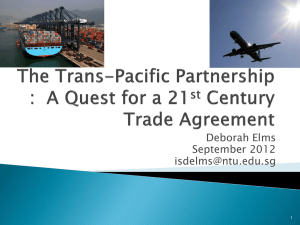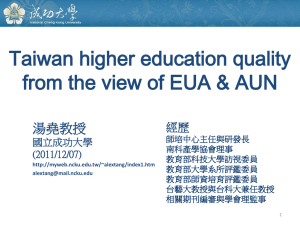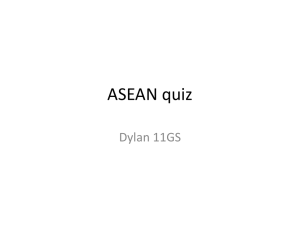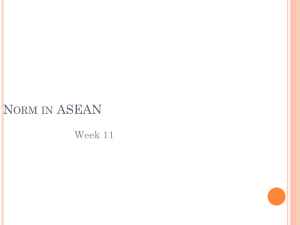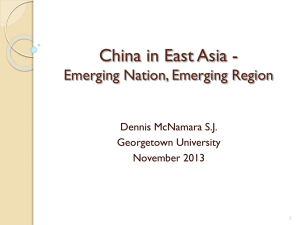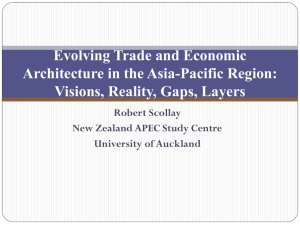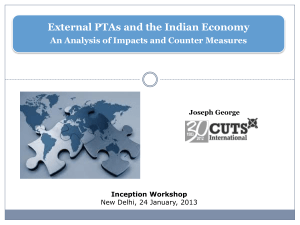Presentation by Professor Ann Capling, University of Melbourne
advertisement
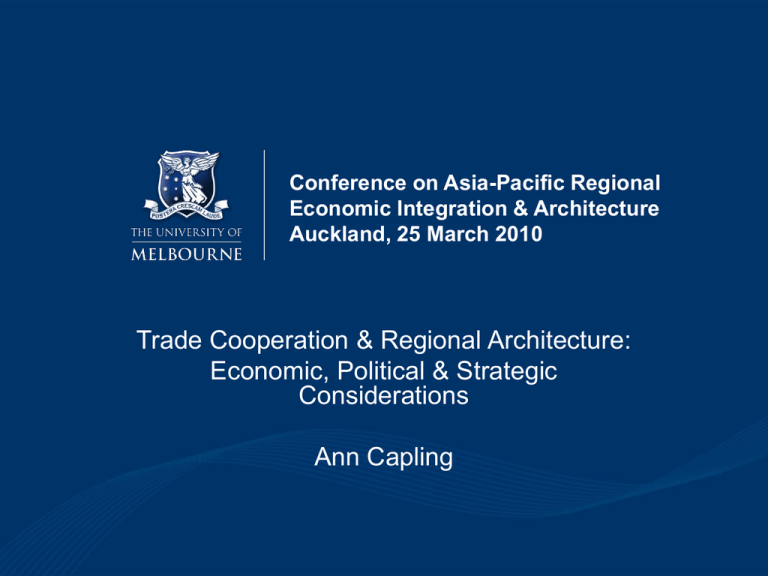
Conference on Asia-Pacific Regional Economic Integration & Architecture Auckland, 25 March 2010 Trade Cooperation & Regional Architecture: Economic, Political & Strategic Considerations Ann Capling Overview 1. Trends in Regional Trade Integration: Unilateral & Bilateral PTAs 2. Regional Trade Initiatives: ASEAN Plus deals, APEC-sponsored initiatives 3. Proposals for Regional Architecture: APc and EAC: what comes next? 4. The TPP: potential & challenges Regional Economic Integration: Key trends 1. Significant unilateral liberalisation: Australia & NZ (bound), ASEAN & India (unbound) 2. Proliferation of PTAs despite APEC commitment to ‘open regionalism’ 3. PTA activity driven by foreign policy, geo-political, strategic & commercial/defensive positions 4. Significant variation in PTAs Consequences Broad ‘types’ of PTAs in Asia-Pacific: 1. US (Aust and NZ): deeply liberalising, comprehensive, WTO-plus 2. Japan (South Korea): less coverage (agriculture) but also WTO-plus with development assistance 3. China (ASEAN): weakly liberalising, less comprehensive in scope & coverage So considerable diversity (esp ROOs), which APEC is addressing (model measures etc) Consequences, cont’d But little evidence that the ‘noodle bowl’ is a problem • Existing low tariffs mean limited take-up by business of preferential access in PTAs • A lot of East Asia’s total trade is intra-regional trade (55 per cent), mostly ICT goods (for export to western countries) • High tariffs and NTBs in some manufacturing sectors, services and agriculture remain Re-balancing? • Financial crisis is said to have accelerated the decline of US & rise of China • Argument that Asian economies should ‘re-balance’ to exploit regional sources of growth as exports to west decline • But this would demand stronger & deeper regional trade agreements • Seems unlikely in mid term due to strong political/nationalist rivalries Regional trade initiatives ‘ASEAN plus’ initiatives 1. 2. 3. • • • • Little progress on ASEAN+3 & +6 ASEAN+1 deals AANZFTA most noteworthy of these ASEAN’s most comprehensive PTA WTO Plus on services and IP Permissive & innovative ROOs Built-in work programs Regional trade initiatives, cont’d 1. 2. 3. 4. APEC initiatives Free Trade Area of the Asia-Pacific, RIP ‘Soft law’ approaches: model measures, transparency & analytical work P4 agreement (2006) Trans-Pacific Partnership Agreement, P4 plus Australia, US, Peru, Vietnam(?) Asia Pacific – A split down the middle? • Fears about ‘split down the middle’ go back to the 1980s • APEC aimed in large part at keeping US constructively engaged, and yet…. • ‘…The US has been absent from the Asia Pacific region…’ (R. Gates, Whitehouse spokesman, March 2010) • Mixed views in region about importance of US engagement in regional institutions… Current Proposals for Regional Architecture • Need to distinguish between tradefocused agreements and those with a broader mandate and agenda • Existing institutions are seen as inadequate (ie. APEC and various ASEAN-centred institutions) • Has given rise to competing proposals from Australia (APc) and Japan (EAC) Asia Pacific community (Australia) Rudd’s initiative for a new process to: • Manage regional economic, political and security dialogues • Manage changing relations between Asia and the US • Manage changing relations among the major powers • Develop and project an ‘Asian’ position in G20 and other global forums • Include India Issues arising (December 2009) • Must be ASEAN-centred (but leadership problem there) • Exclusion of APEC countries in Americas (apart from US) • No appetite for new architecture or meetings • Russia? • Concert of powers? • Overtaken by G20…? • Competition from Japanese proposal for EAC East Asia Community (Japan) • ASEAN + 6 (NE Asia, Australia, NZ and India) • Japanese prefer this to ASEAN + 3 which China would dominate • PM Hatoyama claims desire to trump agricultural protectionism, in favour of stronger econ integration in East Asia • But no US and ASEANs split on desirability of US participation • Competes with Rudd proposal A compromise will have to emerge • Option 1: group that consists of the East Asia members of the G20 plus Australia, India and US • Option 2: EAC (16) plus US & Russia • In the meantime, TPP is the easiest way of keeping the US engaged in the region Trans-Pacific Partnership Agreement TPP could build on the P4 which is a high quality, WTO-plus PTA except in a couple of key respects…. 1. No chapters on investment, financial services 2. Restrictive ROOs – AANZFTA is a better model of liberal ROOs 3. P4 currently involves small liberal economies with little trade between them Questions about the TPP It might be easy to negotiate: • 6 of the 8 already have PTAs with USA • Of 28 dyads, only 8 are not covered by existing PTAs • Obama administration is making this a high priority in light of expressed desire to double exports over next five years But…… TPP: difficult questions 1. Will it be a genuine FTA where all parties have a common schedule for the others? 2. Will the ROOs be highly restrictive (like NAFTA’s) and therefore inhibit greater regional economic integration 3. Agric subsidies etc remain untouched 4. Investor-state DSM? 5. Would US Congress ratify it? And finally a plea… Potentially bigger trade issues looming in the Asia-Pacific region including: • Tensions in trade in natural resourcebased products, especially food and energy • Interface between climate change mitigation policies and trade policy Which can only be dealt with effectively at the WTO…. © Copyright The University of Melbourne 2008

